Production of Tetramethylpyrazine from Cane Molasses by Bacillus sp. TTMP20
Abstract
:1. Introduction
2. Results and Discussion
2.1. Isolation of Bacterial Strain
2.2. Composition of Cane Molasses
2.3. Change of Molasses Composition after Treatment
2.4. Growth of Strain Bacillus sp. TTMP20
2.5. Analysis of Sugar Metabolism
2.6. Utilization of Acetoin
2.7. Production of Tetramethylpyrazine by Fermentation of Molasses with Different Treatments
3. Materials and Methods
3.1. Bacterial Strain, Materials and Culture Medium
3.2. Pretreatment of Cane Molasses
3.3. Analysis of Sugar Content and Acetoin Content
3.4. Measurement of Cell Growth
3.5. HPLC Analysis
4. Conclusions
Author Contributions
Funding
Institutional Review Board Statement
Informed Consent Statement
Data Availability Statement
Conflicts of Interest
Sample Availability
Abbreviations
References
- Chang, C.-Y.; Kao, T.-K.; Chen, W.-Y.; Ou, Y.-C.; Li, J.-R.; Liao, S.-L.; Raung, S.-L.; Chen, C.-J. Tetramethylpyrazine inhibits neutrophil activation following permanent cerebral ischemia in rats. Biochem. Biophys. Res. Commun. 2015, 463, 421–427. [Google Scholar] [CrossRef]
- Wang, G.-F.; Shi, C.-G.; Sun, M.-Z.; Wang, L.; Wu, S.-X.; Wang, H.-F.; Xu, Z.-Q.; Chen, D.-M. tetramethylpyrazine attenuates atherosclerosis development and protects endothelial cells from ox-LDL. Cardiovasc. Drugs Ther. 2013, 27, 199–210. [Google Scholar] [CrossRef]
- Xiao, Z.; Hou, X.; Lyu, X.; Xi, L.; Zhao, J.-Y. Accelerated green process of tetramethylpyrazine production from glucose and diammonium phosphate. Biotechnol. Biofuels 2014, 7, 106. [Google Scholar] [CrossRef] [Green Version]
- Xiao, Z.; Zhao, L.; Tian, L.; Wang, L.; Zhao, J.-Y. GC–FID determination of tetramethylpyrazine and acetoin in vinegars and quantifying the dependence of tetramethylpyrazine on acetoin and ammonium. Food Chem. 2018, 239, 726–732. [Google Scholar] [CrossRef] [PubMed]
- Kosuge, T.; Kamiya, H. Discovery of a pyrazine in a natural product: Tetramethylpyrazine from cultures of a strain of Bacillus subtilis. Nature 1962, 193, 776. [Google Scholar] [CrossRef] [PubMed]
- Larroche, C.; Besson, I.; Gros, J.-B. High pyrazine production by Bacillus subtilis in solid substrate fermentation on ground soybeans. Process. Biochem. 1999, 34, 667–674. [Google Scholar] [CrossRef]
- Besson, I.; Creuly, C.; Gros, J.B.; Larroche, C. Pyrazine production by Bacillus subtilis in solid-state fermentation on soybeans. Appl. Microbiol. Biotechnol. 1997, 47, 489–495. [Google Scholar] [CrossRef]
- Yamaguchi, N.; Toda, T.; Teramoto, T.; Okuhira, T.; Sugawara, E.; Ito, T. Effect of sugars on microbiological pyrazine formation by Bacillus natto in synthetic liquid medium. J. Jpn. Soc. Food Sci. Technol. 1993, 40, 841–848. [Google Scholar] [CrossRef] [Green Version]
- Dionísio, A.P.; Molina, G.; de Carvalho, D.S.; dos Santos, R.; Bicas, J.; Pastore, G. Natural flavourings from biotechnology for foods and beverages. In Natural Food Additives, Ingredients and Flavourings; Woodhead Publishing Series in Food Science; Technology and Nutrition: Soston, UK, 2012; pp. 231–259. [Google Scholar]
- Chan, S.; Kanchanatawee, S.; Jantama, K. Production of succinic acid from sucrose and sugarcane molasses by metaboli-cally engineered Escherichia coli. Bioresour. Technol. 2012, 103, 329–336. [Google Scholar] [CrossRef]
- Chaves, T.C.; Gois, G.N.S.B.; Peiter, F.S.; Vich, D.V.; de Amorim, E.L.C. Biohydrogen production in an AFBR using sugarcane molasses. Bioprocess Biosyst. Eng. 2021, 44, 307–316. [Google Scholar] [CrossRef]
- Li, J.; Chen, S.; Fu, J.; Xie, J.; Ju, J.; Yu, B.; Wang, L. Efficient molasses utilization for low-molecular-weight poly-γ-glutamic acid production using a novel Bacillus subtilis stain. Microb. Cell Factories 2022, 21, 140. [Google Scholar] [CrossRef]
- Pattanakittivorakul, S.; Lertwattanasakul, N.; Yamada, M.; Limtong, S. Selection of thermotolerant Saccharomyces cerevisiae for high temperature ethanol production from molasses and increasing ethanol production by strain improvement. Antonie Van Leeuwenhoek 2019, 112, 975–990. [Google Scholar] [CrossRef] [PubMed]
- Dasgupta, D.; Ghosh, P.; Ghosh, D.; Suman, S.; Khan, R.; Agrawal, D.; Adhikari, D.K. Ethanol fermentation from molasses at high temperature by thermotolerant yeast Kluyveromyces sp. IIPE453 and energy assessment for recovery. Bioprocess Biosyst. Eng. 2014, 37, 2019–2029. [Google Scholar] [CrossRef] [PubMed]
- Deshmukh, A.N.; Nipanikar-Gokhale, P.; Jain, R. Engineering of Bacillus subtilis for the production of 2,3-butanediol from sugarcane molasses. Appl. Biochem. Biotechnol. 2016, 179, 321–331. [Google Scholar] [CrossRef] [PubMed]
- Wang, D.; Oh, B.-R.; Lee, S.; Kim, D.-H.; Joe, M.-H. Process optimization for mass production of 2,3-butanediol by Bacillus subtilis CS13. Biotechnol. Biofuels 2021, 14, 15. [Google Scholar] [CrossRef]
- Li, Y.-R. China: An emerging sugar super power. Sugar Tech 2004, 6, 213–227. [Google Scholar] [CrossRef]
- Silalertruksa, T.; Pongpat, P.; Gheewala, S.H. Life cycle assessment for enhancing environmental sustainability of sugarcane biorefinery in Thailand. J. Clean. Prod. 2017, 140, 906–913. [Google Scholar] [CrossRef]
- Li, S.; Xu, H.; Yu, J.; Wang, Y.; Feng, X.; Ouyang, P. Enhancing isomaltulose production by recombinant Escherichia coli producing sucrose isomerase: Culture medium optimization containing agricultural wastes and cell immobilization. Bioprocess Biosyst. Eng. 2013, 36, 1395–1405. [Google Scholar] [CrossRef]
- Wu, L.; Wu, S.; Qiu, J.; Xu, C.; Li, S.; Xu, H. Green synthesis of isomaltulose from cane molasses by Bacillus subtilis WB800-pHA01-palI in a biologic membrane reactor. Food Chem. 2017, 229, 761–768. [Google Scholar] [CrossRef]
- Valli, V.; Gómez-Caravaca, A.M.; Di Nunzio, M.; Danesi, F.; Caboni, M.F.; Bordoni, A. Sugar cane and sugar beet molasses, antioxidant-rich alternatives to refined sugar. J. Agric. Food Chem. 2012, 60, 12508–12515. [Google Scholar] [CrossRef]
- He, X.; Qi, Y.; Chen, K.; Li, Y.; Ouyang, P. Enhancing l-lysine production of beet molasses by engineered Escherichia coli using an in situ pretreatment method. Appl. Biochem. Biotechnol. 2016, 179, 986–996. [Google Scholar] [CrossRef]
- Jiang, L.; Wang, J.; Liang, S.; Wang, X.; Cen, P.; Xu, Z. Butyric acid fermentation in a fibrous bed bioreactor with immobilized Clostridium tyrobutyricum from cane molasses. Bioresour. Technol. 2009, 100, 3403–3409. [Google Scholar] [CrossRef] [PubMed]
- Bae, S.O.; Shoda, M. Production of bacterial cellulose by Acetobacter xylinum BPR2001 using molasses medium in a jar fermentor. Appl. Microbiol. Biotechnol. 2005, 67, 45–51. [Google Scholar] [CrossRef] [PubMed]
- Lazaridou, A.; Biliaderis, C.G.; Roukas, T.; Izydorczyk, M. Production and characterization of pullulan from beet molasses using a nonpigmented strain of Aureobasidium pullulans in batch culture. Appl. Biochem. Biotechnol. 2002, 97, 1–22. [Google Scholar] [CrossRef] [PubMed]
- Li, Q.; Zhou, Y.; Ke, C.; Bai, Y.; Liu, X.; Li, S. Production of welan gum from cane molasses by Sphingomonas sp. FM01. Carbohydr. Polym. 2020, 244, 116485. [Google Scholar] [CrossRef]
- Clark, D.S.; Ito, K.; Horitsu, H. Effect of manganese and other heavy metals on submerged citric acid fermentation of molasses. Biotechnol. Bioeng. 1966, 8, 465–471. [Google Scholar] [CrossRef]
- Pandey, K.; Agarwal, P.K. Effect of EDTA, potassium ferrocyanide, and sodium potassium tartarate on the production of ethanol from molasses by Saccharomyces cerevisiae. Enzyme Microb. Tech. 1993, 15, 887–898. [Google Scholar] [CrossRef]
- Abou-Zeid, A.; El-Diwany, A.I.; Salem, H.M. Utilisation of molasses as a natural medium for production of mag-namycin by Streptomyces halsted II. Agric. Wastes 1980, 2, 23–30. [Google Scholar] [CrossRef]
- He, X.; Chen, K.; Li, Y.; Wang, Z.; Zhang, H.; Qian, J.; Ouyang, P. Enhanced L-lysine production from pretreated beet molasses by engineered Escherichia coli in fed-batch fermentation. Bioprocess Biosyst. Eng. 2015, 38, 1615–1622. [Google Scholar] [CrossRef]
- Kundu, S.; Panda, T.; Majumdar, S.K.; Guha, B.; Bandyopadhyay, K.K. Pretreatment of indian cane molasses for increased production of citric acid. Biotechnol. Bioeng. 1984, 26, 1114–1121. [Google Scholar] [CrossRef]
- Küçükaşik, F.; Kazak, H.; Güney, D.; Finore, I.; Poli, A.; Yenigün, O.; Nicolaus, B.; Oner, E.T. Molasses as fermentation substrate for levan production by Halomonas sp. Appl. Microbiol. Biotechnol. 2011, 89, 1729–1740. [Google Scholar] [CrossRef]
- Roukas, T. Pretreatment of beet molasses to increase pullulan production. Process Biochem. 1998, 33, 805–810. [Google Scholar] [CrossRef]
- Wang, M.Y.; Yang, J.G.; Zhao, Q.S.; Zhang, K.Z.; Su, C. Research progress on flavor compounds and microorganisms of Maotai flavor Baijiu. J. Food Sci. 2019, 84, 6–18. [Google Scholar] [CrossRef] [Green Version]
- Wang, C.-L.; Shi, D.-J.; Gong, G.-L. Microorganisms in Daqu: A starter culture of Chinese Maotai-flavor liquor. World J. Microbiol. Biotechnol. 2008, 24, 2183–2190. [Google Scholar] [CrossRef]
- Liu, Y.P.; Zheng, P.; Sun, Z.H.; Ni, Y.; Dong, J.J.; Zhu, L.L. Economical succinic acid production from cane molasses by Actinobacillus succinogenes. Bioresour. Technol. 2008, 99, 1736–1742. [Google Scholar] [CrossRef]
- Xu, Y.; Wu, Q.; Fan, W.L.; Zhu, B.F. The discovery and verification of the production pathway of Tetramethylpyrazine (TTMP) in Chinese liquor. Liquor-Making Sci. Technol. 2011, 7, 37–40. [Google Scholar] [CrossRef]
- Xiao, Z.; Lu, J.R. Generation of Acetoin and Its Derivatives in Foods. J. Agric. Food Chem. 2014, 62, 6487–6497. [Google Scholar] [CrossRef] [PubMed]
- Cui, Z.; Wang, Z.; Zheng, M.; Chen, T. Advances in biological production of acetoin: A comprehensive overview. Crit. Rev. Biotechnol. 2022, 42, 1135–1156. [Google Scholar] [CrossRef] [PubMed]
- Xiao, Z.; Xu, P. Acetoin metabolism in bacteria. Crit. Rev. Microbiol. 2007, 33, 127–140. [Google Scholar] [CrossRef] [PubMed]
- Ali, N.O.; Bignon, J.; Rapoport, G.; Debarbouille, M. Regulation of the acetoin catabolic pathway is controlled by sigma L in Bacillus subtilis. J. Bacteriol. 2001, 183, 2497–2504. [Google Scholar] [CrossRef] [PubMed] [Green Version]
- Cui, D.-Y.; Wei, Y.-N.; Lin, L.-C.; Chen, S.-J.; Feng, P.-P.; Xiao, D.-G.; Lin, X.; Zhang, C.-Y. Increasing Yield of 2,3,5,6-Tetramethylpyrazine in Baijiu Through Saccharomyces cerevisiae Metabolic Engineering. Front. Microbiol. 2020, 11, 596306. [Google Scholar] [CrossRef]
- Meng, W.; Ding, F.; Wang, R.M.; Wang, T.F. Enhanced production of tetramethylpyrazine in Bacillus licheniformis BL1 through aldC over-expression and acetaldehyde supplementation. Sci. Rep. 2020, 10, 3544. [Google Scholar] [CrossRef] [PubMed] [Green Version]
- López, J.M.; Thoms, B. Relations between catabolite repression and sporulation in Bacillus subtilis. Arch. Microbiol. 1976, 109, 181–186. [Google Scholar] [CrossRef] [PubMed]
- Li, J.; Lu, J.; Ma, Z.; Li, J.; Chen, X.; Diao, M.; Xie, N. A green route for high-yield production of tetramethylpyrazine from non-food raw materials. Front. Bioeng. Biotechnol. 2022, 9, 792023. [Google Scholar] [CrossRef] [PubMed]
- Hao, F.; Wu, Q.; Xu, Y. Precursor supply strategy for tetramethylpyrazine production by Bacillus subtilis on solid-state fermentation of wheat bran. Appl. Biochem. Biotechnol. 2013, 169, 1346–1352. [Google Scholar] [CrossRef]
- Zhu, B.-F.; Xu, Y.; Fan, W.-L. High-yield fermentative preparation of tetramethylpyrazine by Bacillus sp. using an endogenous precursor approach. J. Ind. Microbiol. Biotechnol. 2010, 37, 179–186. [Google Scholar] [CrossRef]
- Demain, A.L.; Jackson, M.; Trenner, N.R. Thiamine-dependent accumulation of tetramethylpyrazine accompanying a mutation in the isoleucine-valine pathway. J. Bacteriol. 1967, 94, 323–326. [Google Scholar] [CrossRef] [Green Version]
- Shu, C.-K. Pyrazine formation from amino acids and reducing sugars, a pathway other than strecker degradation. J. Agric. Food Chem. 1998, 46, 1515–1517. [Google Scholar] [CrossRef]
- Peng, K.; Guo, D.; Lou, Q.; Lu, X.; Cheng, J.; Qiao, J.; Lu, L.; Cai, T.; Liu, Y.; Jiang, H. Synthesis of Ligustrazine from Acetaldehyde by a Combined Biological–Chemical Approach. ACS Synth. Biol. 2020, 9, 2902–2908. [Google Scholar] [CrossRef]
- Zhu, B.-F.; Xu, Y. A feeding strategy for tetramethylpyrazine production by Bacillus subtilis based on the stimulating effect of ammonium phosphate. Bioprocess Biosyst. Eng. 2010, 33, 953–959. [Google Scholar] [CrossRef]
- Xiao, Z.J.; Liu, P.H.; Qin, J.Y.; Xu, P. Statistical optimization of medium components for enhanced acetoin production from molasses and soybean meal hydrolysate. Appl. Microbiol. Biotechnol. 2007, 74, 61–68. [Google Scholar] [CrossRef] [PubMed]
- Wen, A.; Xie, C.; Mazhar, M.; Wang, C.; Zeng, H.; Qin, L.; Zhu, Y. Tetramethylpyrazine from adlay (Coix lacryma-jobi) biotransformation by Bacillus subtilis and its quality characteristics. J. Food Sci. Technol. 2020, 57, 4092–4102. [Google Scholar] [CrossRef] [PubMed]
- Miller, G.L. Use of dinitrosalicylic acid reagent for determination of reducing sugar. Anal. Chem. 1959, 31, 426–428. [Google Scholar] [CrossRef]
- Levine, M. On the significance of the Voges-Proskauer reaction. J. Bacteriol. 1916, 1, 153–164. [Google Scholar] [CrossRef] [Green Version]
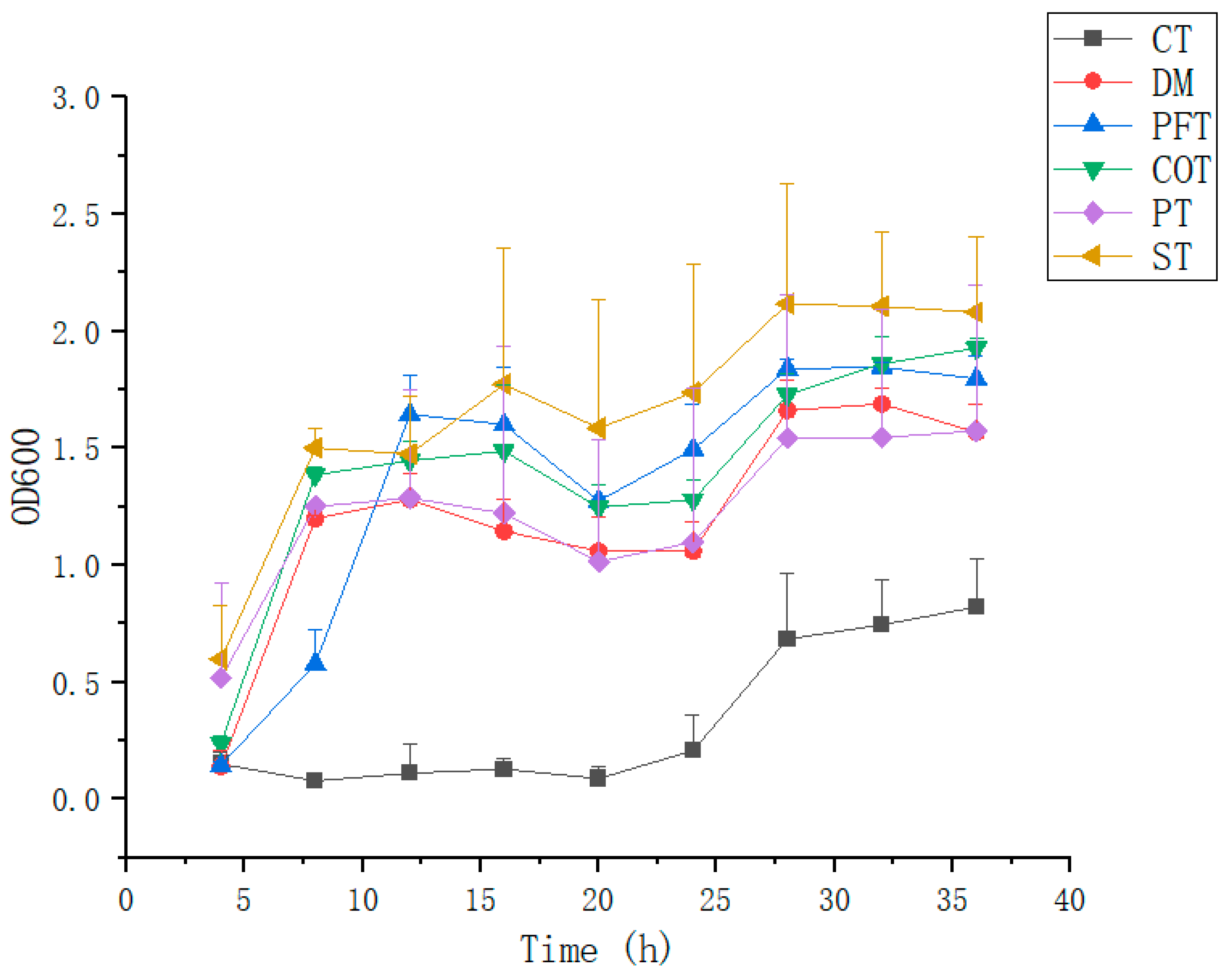
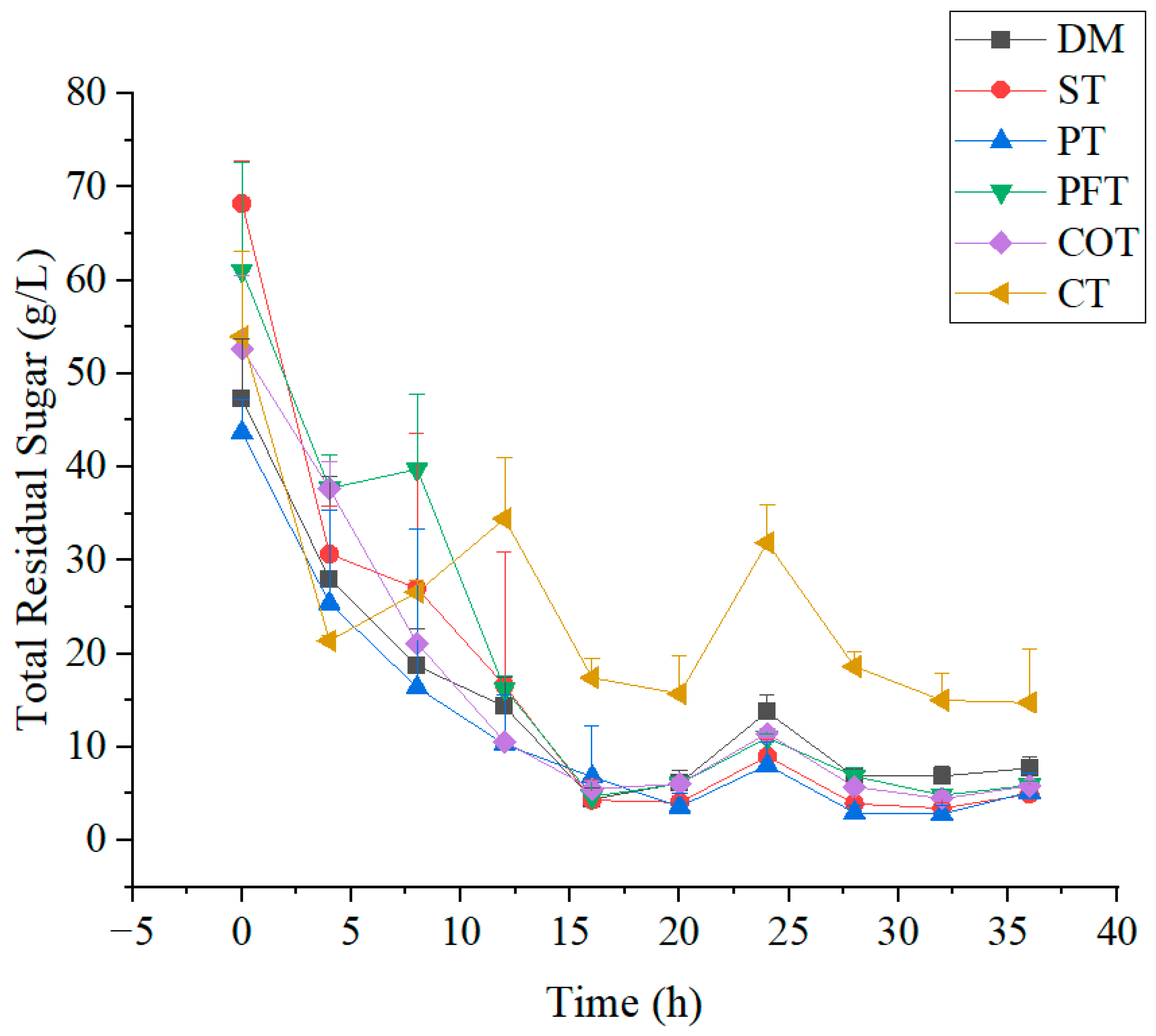

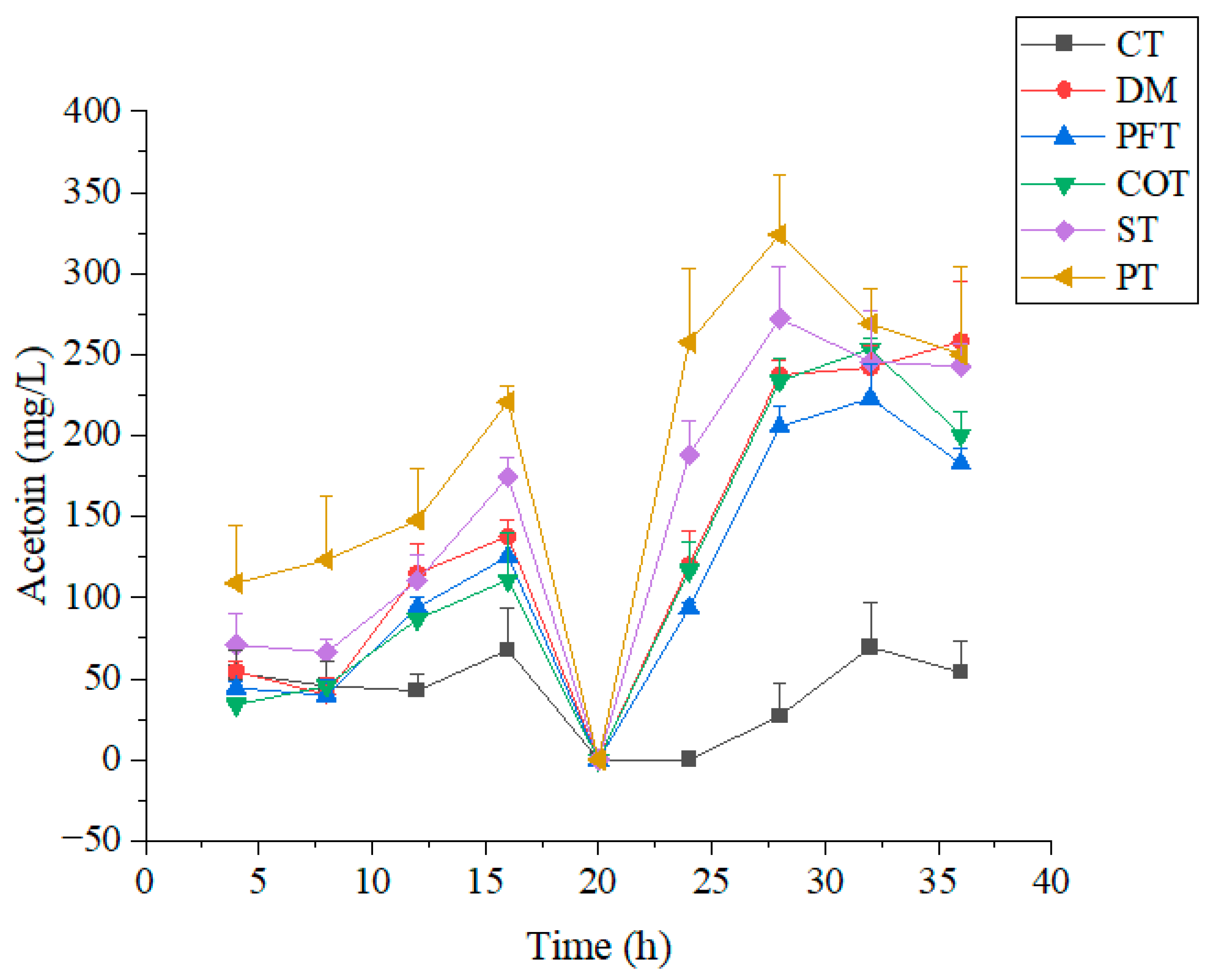
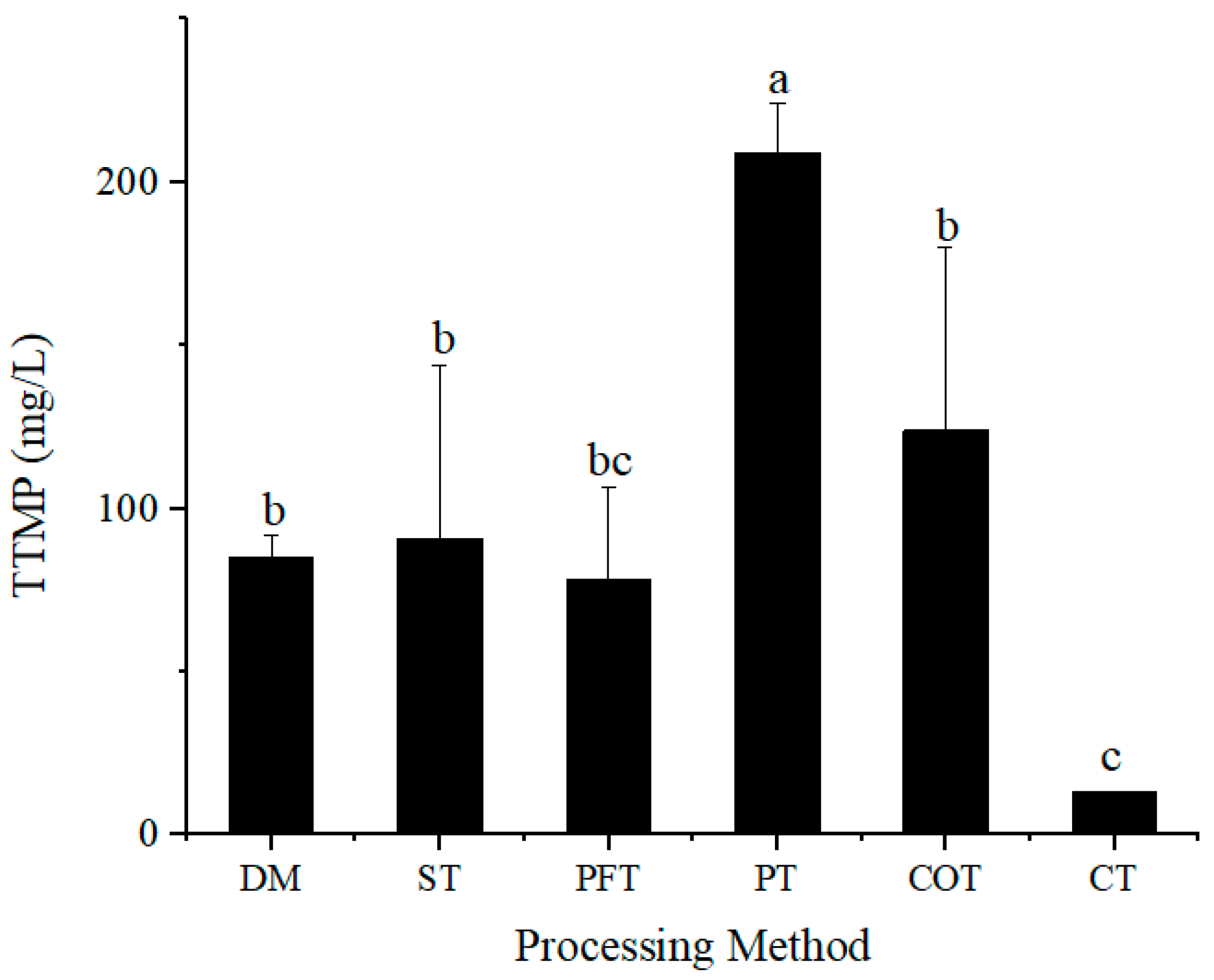
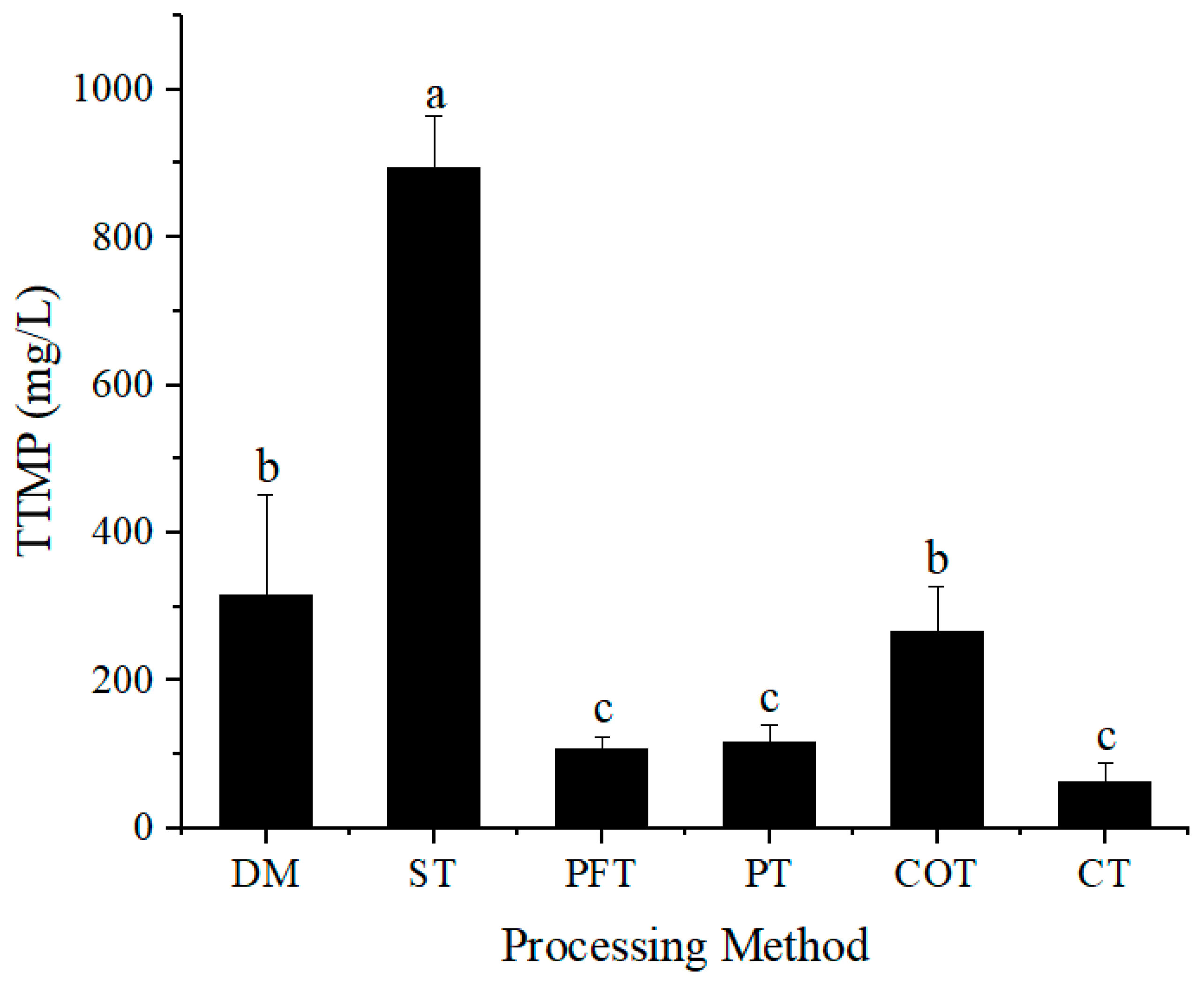
| Composition | Content |
|---|---|
| Total sugars | 37.77% |
| Reducing sugars | 8.55% |
| pH | 4.84 |
| Ash | 8.4% |
| Water | 25.24% |
| Crude protein | 13.25% |
| Pretreatment Methods | Total Sugars (g/L) | Reducing Sugars (g/L) | Sucrose (g/L) | Glucose (g/L) | OD600 |
|---|---|---|---|---|---|
| Diluted molasses (DM) | 423.24 ± 57.11 a | 109.05 ± 19.45 bc | 45.22 ± 3.83 a | 32.8 ± 2.26 b | 1.56 ± 0.12 ab |
| ST | 401.54 ± 97.95 a | 142.57 ± 30.85 b | 38.59 ± 0.17 a | 34.32 ± 2.73 b | 2.08 ± 0.32 a |
| PT | 248.98 ± 16.61 b | 75.67 ± 8.23 c | 40.14 ± 4.62 a | 33.49 ± 0.31 b | 1.57 ± 0.84 ab |
| PFT | 345.63 ± 49.30 ab | 85.48 ± 10.39 c | 37.7 ± 3.21 a | 30.4 ± 0.80 b | 1.79 ± 0.10 a |
| COT | 456.67 ± 119.41 a | 113.53 ± 31.66 bc | 42.36 ± 5.77 a | 31.27 ± 5.88 b | 1.92 ± 0.05 a |
| CT | 312.53 ± 23.37 ab | 200 ± 17.22 a | 14.26 ± 1.09 b | 45.61 ± 0.87 a | 0.82 ± 0.21 b |
Disclaimer/Publisher’s Note: The statements, opinions and data contained in all publications are solely those of the individual author(s) and contributor(s) and not of MDPI and/or the editor(s). MDPI and/or the editor(s) disclaim responsibility for any injury to people or property resulting from any ideas, methods, instructions or products referred to in the content. |
© 2023 by the authors. Licensee MDPI, Basel, Switzerland. This article is an open access article distributed under the terms and conditions of the Creative Commons Attribution (CC BY) license (https://creativecommons.org/licenses/by/4.0/).
Share and Cite
Li, Y.; Luo, L.; Ding, X.; Zhang, X.; Gan, S.; Shang, C. Production of Tetramethylpyrazine from Cane Molasses by Bacillus sp. TTMP20. Molecules 2023, 28, 2640. https://doi.org/10.3390/molecules28062640
Li Y, Luo L, Ding X, Zhang X, Gan S, Shang C. Production of Tetramethylpyrazine from Cane Molasses by Bacillus sp. TTMP20. Molecules. 2023; 28(6):2640. https://doi.org/10.3390/molecules28062640
Chicago/Turabian StyleLi, Yujia, Lirong Luo, Xiaoxiao Ding, Xiumin Zhang, Shanling Gan, and Changhua Shang. 2023. "Production of Tetramethylpyrazine from Cane Molasses by Bacillus sp. TTMP20" Molecules 28, no. 6: 2640. https://doi.org/10.3390/molecules28062640





